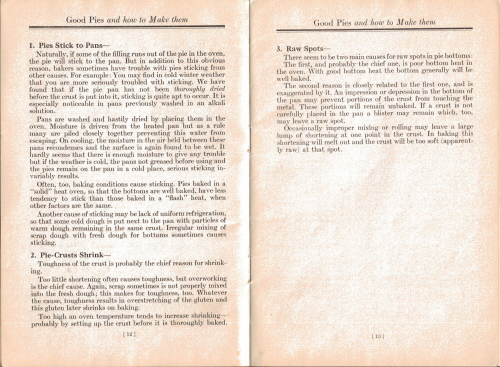 Here are pages 11 (part), 12 and 13 of the vintage recipe booklet “Good Pies & How To Make Them” that was published in 1928 by Crisco.
Here are pages 11 (part), 12 and 13 of the vintage recipe booklet “Good Pies & How To Make Them” that was published in 1928 by Crisco.
To review all pages in this booklet, simply visit the Crisco: Good Pies & How To Make Them Category and click on a page title to review that section.
There are scans available of each page, just click the images to view a full size copy.
Difficulties with Crusts; How to Avoid Them
By the following the foregoing suggestions you should have no trouble making uniformly good pie-crust.
However, there are a few difficulties you may occasionally run up against. So we will point out the reasons for them and suggest the remedies.
1. Pies Stick to Pans–
Naturally, if some of the filling runs out of the pie in the oven, the pie will stick to the pan. But in addition to this obvious reason, bakers sometimes have trouble with pies sticking from other causes. For example: You may find in cold winter weather that you are more seriously troubled with sticking. We have found that if the pie pan has not been thoroughly dried before the crust is put into it, sticking is quite apt to occur. It is especially noticeable in pans previously washed in an alkali solution.
Pans are washed and hastily dried by placing them in the oven. Moisture is driven from the heated pan but as a rule many are piled closely together preventing this water from escaping. On cooling, the moisture in the air held between these pans recondenses and the surface is again found to be wet. It hardly seems that there is enough moisture to give any trouble but if the weather is cold, the pans not greased before using and the pies remain on the pan in a cold place, serious sticking invariably results.
Often, too, baking conditions cause sticking. Pies baked in a “solid” heat oven, so that the bottoms are well baked, have less tendency to stick than those baked in a “flash” heat, when other factors are the same.
Another cause of sticking may be lack of uniform refrigeration, so that some cold dough is put next to the pan with particles of warm dough remaining in the same crust. Irregular mixing of scrap dough with fresh dough for bottoms sometimes causes sticking.
2. Pie-Crusts Shrink–
Toughness of the crust is probably the chief reason for shrinking.
Too little shortening often causes toughness, but overworking is the chief cause. Again, scrap sometimes is not properly mixed into the fresh dough; this makes for toughness, too. Whatever the cause, toughness results in overstretching of the gluten and this gluten later shrinks on baking.
Too high an oven temperature tends to increase shrinking–probably by setting up the crust before it is thoroughly baked.
3. Raw Spots–
There seem to be two main causes for raw spots in pie bottoms:
The first, and probably the chief one, is poor bottom heat in the oven. With good bottom heat the bottom generally will be well baked.
The second reason is closely related to the first one, and is exaggerated by it. An impression or depression in the bottom of the pan may prevent portions of the crust from touching the metal. These portions will remain unbaked. If a crust is not carefully placed in the pan a blister may remain which, too, may leave a raw spot.
Occasionally improper mixing or rolling may leave a large lump of shortening at one point in the crust. In baking this shortening will melt out and the crust will be too soft (apparently raw) at that spot.
 More Recipes For You To Enjoy:
More Recipes For You To Enjoy:




